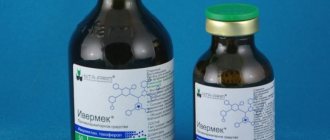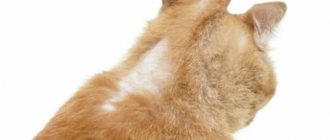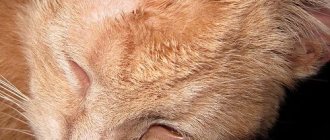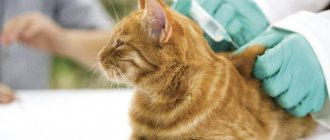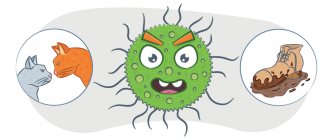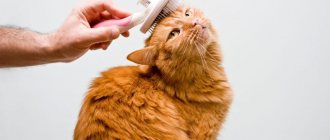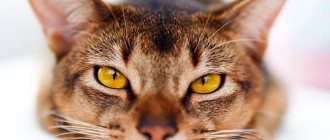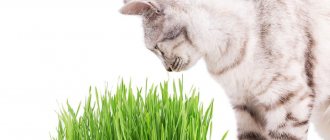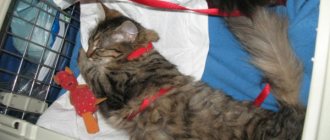What is lichen
The term “feline ringworm” refers to a group of skin diseases with similar clinical signs but different etiologies.
A cat may have ringworm:
- Ringworm, its causative agent is a fungus of the genus Microsporum and Trichophyton. Symptoms: baldness of an area of the skin with smooth edges (as if the hair had been cut), peeling and the formation of crusts in this place. The disease is also called Trichophytosis, Microsporia, Dermatophytosis. Contagious to people. Infection occurs through contact with a sick animal or person.
- Pityriasis or multi-colored (the causative agent is the yeast-like fungus Pityrosporum, which is present on the skin of all animals and in 90% of people). It is activated in hot weather, when the skin becomes excessively oily due to the active work of the sebaceous glands. Symptoms in cats: the appearance of multi-colored spots (pale pink, pink, yellow, brown) on the animal’s body, which gradually increase and merge into one, there is no itching. Contagious to cats and people.
- Shingles or pink (an infection of non-fungal origin, occurs when the body’s defenses are reduced or allergies). It looks like the appearance of a small pink hairless area on the body. Does not pose a danger to people or other cats.
- Weeping eczema (the disease is conditionally classified as lichen, since it occurs during allergic reactions to chemicals, with a lack of vitamins, stress, after burns). Clinical manifestations are a bald area of skin with a moist surface. Not contagious to others.
All forms of lichen tend to spoil the appearance of a cat (due to hairless areas with wounds), which is very frightening for owners and surrounding people.
Action
Administration of Vakderma forms the animal's immunity to dermatophytosis, 25 - 30 days after double use with an interval of 10 - 14 days.
Post-vaccination immunity lasts for one year.
In one immunizing dose of the product, the saturation of fungal particles is approximately 30 - 50 million / cm 3.
The vaccine can be used without special precautions, as it is harmless, areactogenic, and has therapeutic and preventive properties. Vaccination of pets who have an incubation period for dermatophytoses stimulates the accelerated manifestation of symptoms of mycosis in the areas where pathogens are localized in the form of single or multiple mycotic foci on the animal’s skin
Vaccination of pets who have an incubation period for dermatophytosis stimulates the accelerated manifestation of symptoms of mycosis in the areas where pathogens are localized in the form of single or multiple mycotic foci on the animal’s skin.
After 10 days, you need to repeat the drug twice.
Is it possible to develop immunity to fungus?
Cats do not develop resistance to fungal forms of lichen after an illness. General immunity is produced exclusively by blood cells when a foreign agent penetrates the bloodstream.
Lichen fungi do not penetrate blood vessels and live on the surface of the skin and in the animal’s fur. Accordingly, a cat that has once had shingles can become infected again.
There is a theory about the presence of local (skin) immunity in the body of living beings. That is, skin leukocytes recognize antigens (in this case, fungi) and produce antibodies to them. Moreover, lichen fungi come into contact with the surface of the skin. It is on this fact that the assumption about the effectiveness of vaccinations against lichen is based.
Antiviral agents
Antiviral drugs are used for herpes zoster and lichen rosea. It is advisable to take them in the first 72 hours from the onset of the disease - this will speed up recovery and avoid complications. Antiviral drugs for lichen:
- Acyclovir. Its action is selective and directed at cells modified by the virus. The course of treatment is 5 days. Every 6 hours take 4 tablets. For children, the dosage is selected on an individual basis, depending on weight. Acyclovir is also available in ointment form.
- Valtrex is taken 1000 mg 3 times a day. It is not recommended for patients with liver and kidney pathologies.
- Valaciclovir. The duration of taking medications is 7 days. The patient takes 1000 mg every 8 hours. The course of treatment is a week. Children under 12 years of age are contraindicated. Elderly patients are advised to drink plenty of fluids during treatment.
- Famvir. The dosage for taking the medicine per day is 750 mg. It can be taken in equal parts throughout the day or drunk all at once. This medicine for lichen is taken for people for 7 days. The drug has analogues: Famacivir and Menaker.
Is vaccinating cats against lichen effective?
Today, only Russian vaccines for the prevention of lichen in animals are available in veterinary pharmacies. Abroad, such remedies have disappeared and are not used due to the low prevalence of the disease.
Since in Russia lichen is very often registered in agriculture, fur farming and among domestic pets, there is a demand for preventive biological products. However, to date, no pharmaceutical company has published reliable data or studies that support the effectiveness of vaccinating animals against zoster.
Science has not proven that antifungal vaccines can protect against possible infection. Even if you repeatedly vaccinate kittens or rabbits against lichen, upon contact with the pathogen, the animals still get sick and go through all stages of clinical development on a par with those who were not vaccinated.
The effectiveness of the vaccine was studied on a small group of experimental animals, the result was positive, so a vaccine against lichen exists.
In fact, biological products (such as vaccines) require larger studies and many animals with lichen (and pets are selected based on similar physiological parameters and the same stage of development of the disease), which is extremely difficult and financially expensive. Therefore, many experienced veterinary specialists are convinced that vaccinations against lichen are not a preventive measure. However, vaccine manufacturers have their own point of view on this matter.
Complications after vaccination
With the correct dosage, the drug is well tolerated by cats and rarely causes adverse events.
Side effects that may occur in an animal after vaccination include:
- Painful lump at the injection site. Occurs when a cold solution is injected into a cat or an unsterile syringe is used. This symptom does not require treatment and goes away on its own in 3-5 days.
- Slight drowsiness. May bother you for up to 3 days.
If your pet experiences undesirable reactions after the injection, he should be given rest for up to 5 days.
Vakderm is not safe for the liver, so it can only be used as prescribed by a veterinarian.
Ringworm vaccines for cats
Today, Russian veterinary medicine has four vaccines in the form of injections, which are prescribed for lichen in cats, dogs and fur-bearing animals.
Vaccerm Vaccine for cats
The biological product is a dry or liquid mass with inactivated spores of dermatophytes (fungi of the genus Microsporum canis, Microsporum gypseum and Trichophyton mentagrophytes).
The drug Vakderm was created for the immunization of healthy cats, dogs, rabbits and fur-bearing animals, as well as for identifying infected animals. If the cat has previously been in contact with a shingles animal, but clinical signs have not yet appeared, then after vaccination the process will accelerate. But the vaccination will not harm a completely healthy cat and no signs of disease will appear.
According to the manufacturer of the Vakderm vaccine:
- the vaccination has a therapeutic effect, if it is given three times (1 time to detect the disease, 2 and 3 times to speed up healing when lichen has been detected), then after 15-25 days the animal will recover;
- After immunization, animals become immune to lichen for 1 year.
Recommended scheme for administering injections against lichen for cats:
- The first vaccination of kittens is permissible from 30 days of age, adult cats - at any age;
- repeat injection - after 14 days and wait 25 days until stable immunity is developed.
Injections are given intramuscularly at any time of the year.
You cannot vaccinate cats with Vakderm in the second half of pregnancy.
Possible reactions after vaccination: drowsiness of the cat for 2-3 days and painful swelling at the injection site (goes away after a few days).
Important! If a dry vaccine is purchased, the drug should be used within half an hour after dilution.
Vakderm F
This vaccine is exclusively for cats because it consists of inactivated feline ringworm spores. The drug is completely similar to the Vakderm vaccine in terms of the principle of action, regimens of use, and contraindications. It differs only in that it has a mono composition, while Vakderm consists of a mixture of lichen spores from different species of animals.
Vaccine Polivak-TM
This is a shingles vaccine for cats that includes 8 varieties of mushrooms. Specially adapted for domestic cats. The vaccine is produced by (Narvak).
Manufacturers recommend starting vaccination of healthy kittens at the age of 1-3 months, adult cats - at any age, twice, with an interval of 14 days. After 30 days from the last injection, cats develop immunity to microsporia and other forms of lichen, which lasts for 12 months.
If the animal lives in an unfavorable environment, then a year later a revaccination is carried out, which must be repeated annually.
When treating lichen, sick cats are vaccinated three times with an interval of 2 weeks. After 1 month the animal recovers.
According to the stated principle of action, Polivac is no different from Vakderm, only the manufacturers are different.
Microderm
The vaccine is produced by Microderm. The drug is more expensive in cost than previous drugs.
Microderm is intended for the treatment and prevention of dermatophytoses (from microsporia and trichophytosis) in cats, dogs, rabbits and nutria.
The method of administration of this vaccine is similar to analogues: a healthy kitten is vaccinated twice and repeated annually. Sick cats are injected with Microderm once into the muscle. After 2 weeks, a pronounced therapeutic effect is observed, which is manifested by the rejection of epithelial scales and the growth of new hairs.
Prophylactic use of the vaccine does not cause the development of the disease in healthy animals. Immunity develops approximately 3-4 weeks after the last vaccination.
Composition and expiration date
The vaccine is based on fungal cultures of dermatophytes Trichophyton mentagrophytes, Microsporum gypseum and Microsporum canis, inactivated by formaldehyde. It is produced in the form of a homogeneous yellowish-brown suspension or a dry porous mass of the same color.
The drug must be used within 1 year from the date of production. It is recommended to keep it in its original packaging (ampoules or bottles placed in a cardboard box) in a cool place protected from sunlight at a temperature of +2...+10 °C.
The vaccine can be stored for no longer than 30 minutes after opening the container.
Treatment concept
It is immediately worth noting that all dermatophytoses, regardless of the type of pathogen (Trichophyton or Microsporium), are treated according to the same scheme, with the only difference being that the method will depend on the form of the disease.
Therapeutic measures are primarily aimed at destroying the pathogen, and are also designed to alleviate the signs of the disease, in particular itching, and prevent the development of purulent dermatitis.
Vaccination against lichen
Therapeutic vaccination
The most effective and fastest way to get rid of fungal infections of the skin and coat is to use a cat lichen vaccine. There are its varieties:
- vakderm,
- microderm,
- Polivac TM.
Injections are carried out intramuscularly two to three times with an interval between injections of 10-14 days. In principle, the use of immune drugs in therapeutic doses is quite sufficient for the animal to be cured. Already on the 15th day after the first injection, you can notice signs of recovery.
Vaccination against lichen is prohibited for pregnant or lactating cats, pets with elevated temperatures, as well as animals with non-contagious or infectious pathological processes.
Local treatment
In cases where the use of the vaccine is contraindicated, they resort to antifungal ointment, solution, and also bathe the animal with special anti-lichen shampoos intended for cats (sold in almost any veterinary pharmacy).
Topical treatment of ringworm in cats is of minor importance due to the large amount of hair. To increase the effectiveness of treatments, it is advisable to completely shave your pet, this is especially true for long-haired breeds. All hair must be burned after cutting!
Local processing is carried out:
- solutions of salicylic alcohol or iodine monochloride,
- antifungal liniments griseofulvin, miconazole, clotrimazole.
In these cases, it is better to purchase an anti-lichen spray for cats - it is much more convenient to use and the fur will not be sticky and dirty from a greasy substance.
At least once a week, the surface of the body is completely treated with a solution intended for this purpose, for example, chlorhexidine, or bathed with shampoo.
Local treatment is appropriate for local lesions
Systemic therapy
In case of deep lesions, as well as in the development of purulent dermatitis, they resort to systemic treatment - tablets or injections of antibacterial and antifungal drugs are prescribed for a more effective effect on the pathogen.
Unconventional approach
There are also folk remedies for the treatment of lichen in cats. What is not used as such:
- garlic solutions,
- starch,
- alcohol,
- vinegar,
- salt and soda,
- propolis,
- burnt paper,
- all kinds of mash based on fish oil and zinc powder,
- ash,
- iodine,
- celandine,
- tar and much more.
In principle, no one prohibits their use as a cure for lichen for cats, but will there be any result?
Tar is used to treat lichen
Classification of medications
The causes of the pathology may vary, so the choice of medication is always made on an individual basis. Pityriasis versicolor can be caused by yeast-like fungi, while ringworm is caused by dermatophyte fungi. Shingles appears due to contact of the body with the Varicella-Zoster virus, pink - due to allergies.
Modern remedies for lichen can be divided into 2 main groups: local and systemic action. The first are gels and ointments, and the second are oral forms of drugs: these include tablets, drops, capsules. If a mild form of the disease is diagnosed, local medications are prescribed; if they are ineffective, pills are added. The following groups of drugs are used depending on the type of disease:
- antifungal;
- antiviral;
- immunomodulators;
- antibacterial;
- antihistamines.
Shampoos
How to cure lichen in cats using shampoos? These products are recommended to be used in combination with antifungal ointments. This will significantly speed up the healing process.
For ringworm and pityriasis versicolor, the use of shampoos based on antifungal components is indicated. Most often, veterinarians prescribe the following medications:
- "Nizoral." This is one of the most effective drugs against pityriasis versicolor and ringworm. Its active component is ketoconazole. This substance destroys the fungus and stops its spread through the skin.
- "Sebozol." This shampoo is an analogue of Nizoral in terms of the active ingredient. However, its price is much lower. The product is also available in the form of an ointment, which is recommended for use with shampoo.
Antifungal shampoos have a fairly short period of action. Therefore, they should not be used as the only treatment for lichen in cats. In the photo below you can see how wool is treated with shampoo.
Such water procedures must be carried out several times a week. The shampoo must be applied to the coat and left for the time specified in the instructions (about 10 - 15 minutes). The effect becomes noticeable after 6 - 7 weeks. Antifungal shampoos should not be mixed with conventional hygiene products for washing wool.
Tablet drugs
How to treat a cat for lichen if the disease is already advanced? In severe cases, it is impossible to manage only with the use of local remedies. It is necessary to take antifungal medications in tablets.
However, it is not recommended to bring the pathology to such advanced stages. After all, antifungal medications in tablets are often toxic and have a large number of side effects.
The most common drugs from the triazole group are:
- "Itraconazole"
- "Ketoconazole".
- "Fluconazole".
These agents suppress the formation of protein in fungal cells, which leads to the death of the microorganism. Antifungal drugs from the triazole group can have toxic effects on the liver and kidneys. Therefore, during the course of treatment it is necessary to periodically examine the function of these organs.
In some cases, Griseofulvin is prescribed, an antimycotic antibiotic that disrupts the cellular structure of the fungus and suppresses the proliferation of the microorganism. This is an old but quite effective remedy for treating ringworm in cats at home. The tablets can be crushed and added to food. This antibiotic is strictly contraindicated in pregnant cats, as it causes abnormalities in the skeletal structure of future kittens.
It is important to remember that most tablets for treating ringworm in cats are human products.
Such medications should be used with caution and must be prescribed by a veterinarian. Only a doctor can calculate the required dosage of such medications taking into account the weight of the animal
Antifungal tablets are contraindicated in kittens and pregnant and lactating cats.
Only a doctor can calculate the required dosage of such medications taking into account the weight of the animal. Antifungal tablets are contraindicated in kittens, as well as pregnant and lactating cats.


